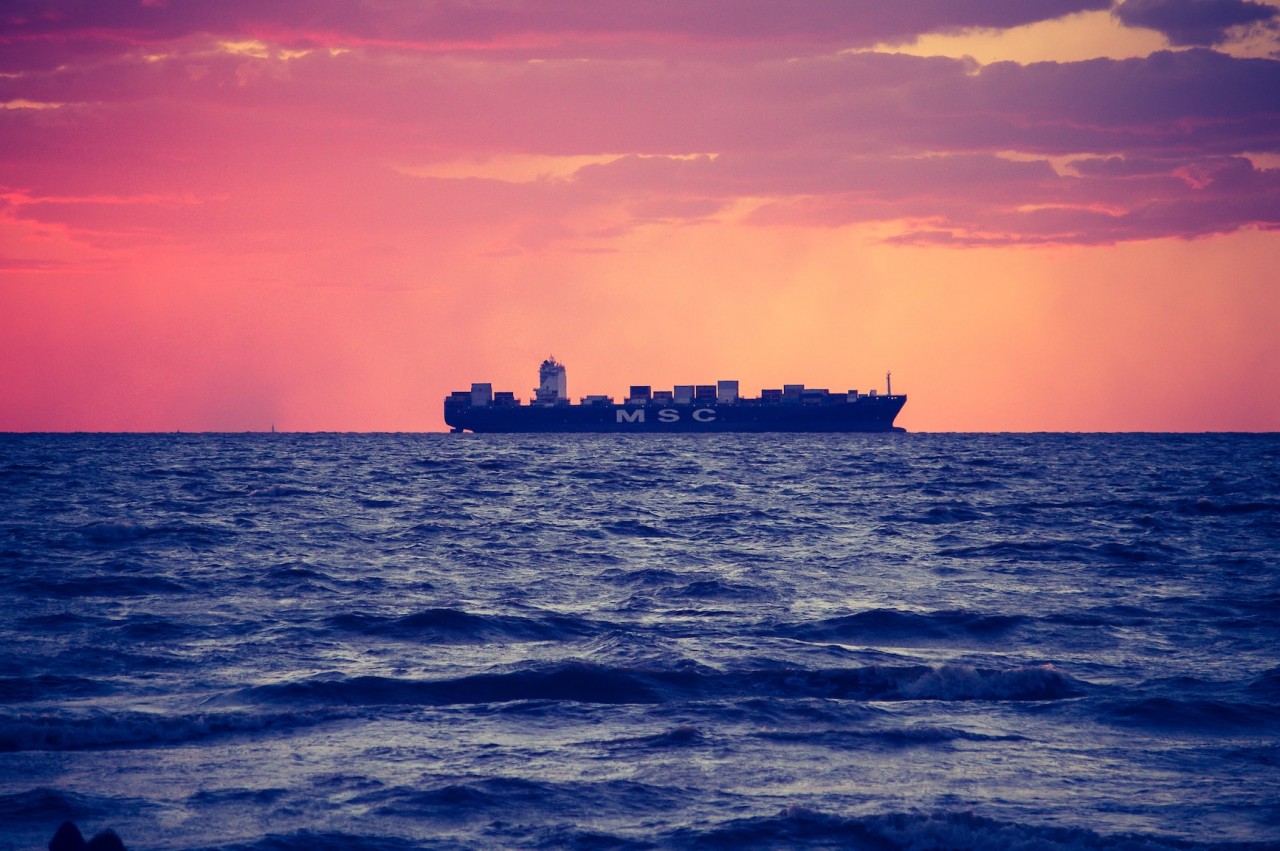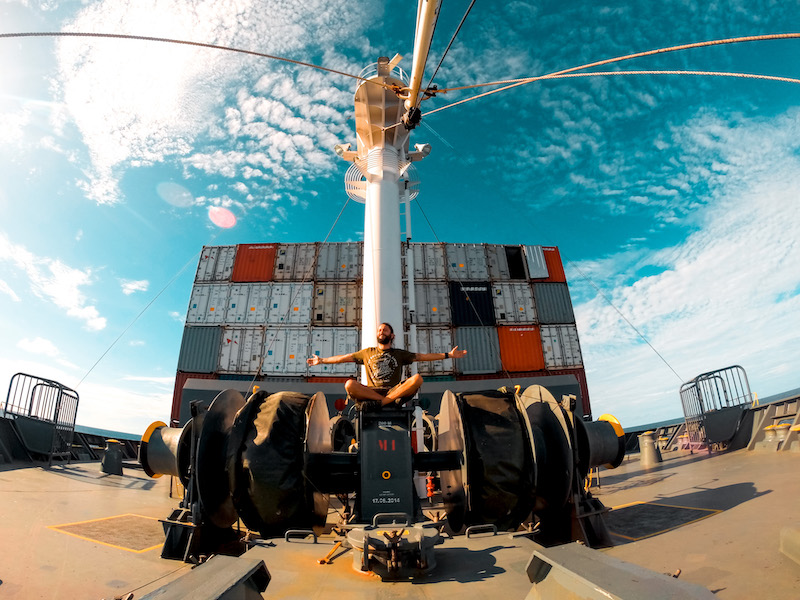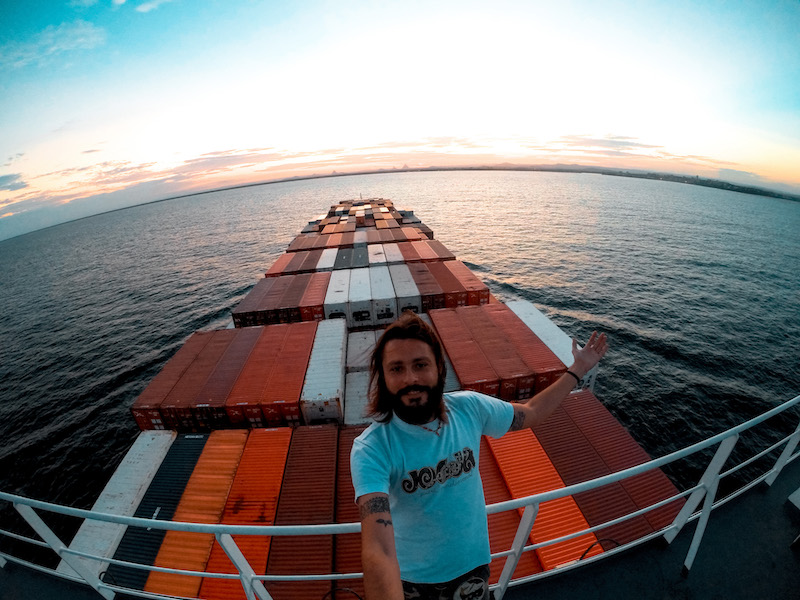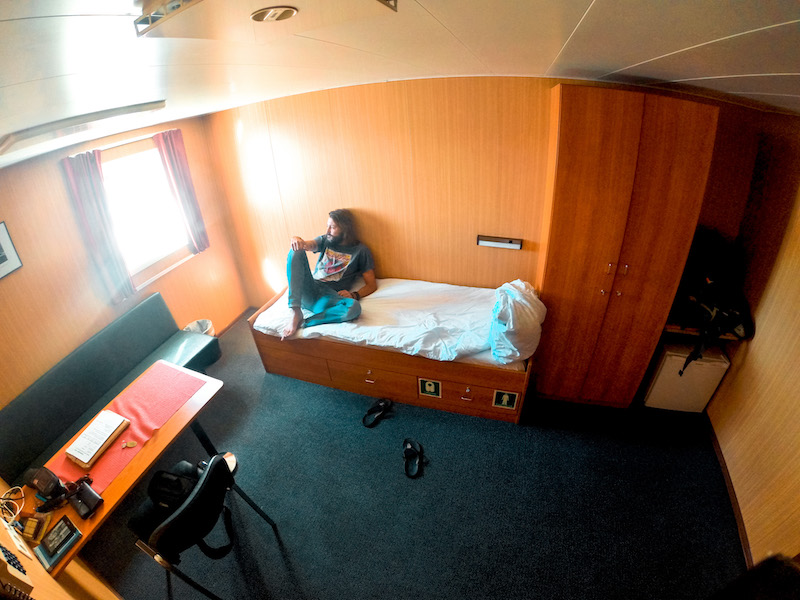
9 minutes reading time
(1755 words)
How to cross an ocean on a cargo ship
CARGO SHIPS: COSTS / BENEFITS AND HOW TO BOOK A PASSAGE ON A CARGO SHIP
One of the things that most leaves people who listen to the story of my tour of the world without planes speechless is the coverage of the distance between one continent and another on merchant cargo ships. Perhaps because no one ever thinks of those huge cities of floating containers as a means of travel to be a traveler - much less to be a tourist! Or maybe because they don't even know what they are and what they are for. The fact is that this is the case: the merchant cargo is the second topic that most intrigues of my trip around the world.
Between the waves of the Oceans, the journey is absolutely slow and boring, completely wacky and disconnected from the real world, but it is definitely an epic journey!
How it works: first of all forget the idea of being able to work or scrounge a passage directly to the port in exchange for some help, it is not possible, or rather, it is no longer possible. To work on a cargo ship you need to be highly qualified and pass a selection process carried out by the transport company through its recruitment channels. Assuming it can be selected, the minimum contracts at the lowest level of the job hierarchy are equal to nine months of boarding. Another not indifferent detail: if you are admitted you will not be able to choose the route to take. The option of going to the pier of a port to try to convince captains to take you onboard is therefore impracticable also because to access these commercial piers you must present a passport and above all valid boarding documents so as not to be rejected at the entrances. So you just have to find out which are the favorite bars of the officers and convince them by getting them drunk….
So, ultimately, how can you get on board? Paying a ticket! Therefore, some companies transporting maritime goods, thanks to technological progress, require an ever-smaller number of employees on board, therefore on some boats, they enjoy free cabins, often sold to passengers who intend to cross the oceans in this way. Not all companies welcome passengers on board and others do not have permits, so these types of passes are limited. Consider, for example, that Chinese companies do not allow passenger services and they hold a large share of the world maritime transport market.
To find a ride on a cargo ship, you have two options: contact the shipping companies directly to ask if they admit passengers and how, if necessary, to purchase the ticket, or contact an intermediary. It goes without saying that the second option is the least economical, but it has its great advantages especially if you are a beginner in this area. In fact, in addition to negotiating a price and buying the ticket, the shipping company will have to provide you with a series of official documents necessary for the exit and entry customs at the destination. The lack of even a single document will not allow you to board and no one will wait for you, since the cargo ship sails and docks only and exclusively for the goods transported. Passengers are the lowest in priority. No boarding and total loss of the cost of the ticket. A ticket that will be anything but cheap! A passage on a cargo ship costs about $ 70 to $ 150 per day and depends on:
• purchase through an intermediary or directly from the company;
• type of cabin;
• port agency;
• port taxes.
Generally, the intervention commission of an intermediary translates into a price increase of about 30%, but with it you will be sure that you have all the documentation in order, that you will be promptly notified about any change in date and time the rule, not the exception!), to have a port agent available to coordinate with on the day of boarding and finally you will be sure to have the guarantee that, if something goes wrong before boarding for reasons not attributable to your negligence, you will be refunded.
What is included in the diary cost? You will be entitled to the full board in a private cabin. If you think about it, its relative cost is therefore not high if you consider, for example, that on my trip around the world, the cabins of cargo ships were the most beautiful accommodations I have ever slept in. They are fairly large and usually have a private bathroom equipped with a shower, a wardrobe, drawers under the bed, some shelves, a chair, and a desk. Three meals a day are served: breakfast around 7, lunch at 12, and dinner at 17.30. There are two canteens available on the ships: that of the officers and that of the crew. As a paying passenger, you will be reserved a seat in the officers' mess but, if you wish, you can decide to eat with the crew instead. I often dined with them because the cooks in the vast majority of cases are of the same nationality as the crew (I found many Filipinos) while the officers come instead from Europe and often from the East. So, already Russian cuisine is not the best, if then cooked by a Filipino cook, it hardly met my tastes: I preferred to eat simpler dishes but cooked well, than a richer dish but cooked poorly! But then I also had the shameless luck of embarking on a cargo ship of an Italian company with an Italian cook from Sorrento and I regained many of the kilos lost previously on the trip.
LIFE ON BOARD
You will probably be the only passenger on board; at most there will be a couple of them to keep you company, so the only people you will meet on the ship will be those of the crew and the officers who are working, so be respectful. Usually, you can freely walk around the ship as long as the Captain authorizes you and you can safely chat with officers or crew, but always remember that you could also be a source of the disturbance. In my personal experience, I have met many beautiful people with whom it was a pleasure to share those long days on board, but once I also met a Captain who did not allow me to get on the bridge and enjoy spectacular sunsets from the most privileged position. It is very important to remember that when the ship is docking in port or setting sail, you will not have to disturb anyone in any way, because it is the most delicate moment in which everyone is more concentrated and attentive. In short, prepare to be often alone, in the company only of yourself because, I'm sorry for animal lovers, but they are never allowed in any way.
Onboard there is often a small gym, sometimes a swimming pool and always a common area with sofas, televisions, books and boxed games. An ocean crossing involves a route of at least twenty days to the Pacific and ten to the Atlantic so you will spend most of your time in the cabin or on the decks alone. Bring lots of books and a good archive of films on your hard drive if you don't want to die of boredom! Forget the internet or telecommunications, there were times on the road when I was thousands of miles from the first coast! It is a very strong experience, with a strong introspective impact and in which you really realize what small space you occupy in the world: you are on board a boat of over 200 meters that transports thousands of containers in the middle of a sea of which the borders are not visible and under the keel, there are thousands of meters deep. At night the darkness is pitch-black and the visible stars are infinite, clear as you have never been able to observe them.
WHERE TO BOOK
Poetic dimension aside, I would like to point out some useful tips and sites for embarking on a journey like this:
- Search Google for the names of the main companies and associate them with the word "freighter" or "cargo vessel" so you can find the email addresses to write directly to the companies and get better prices;
- Try the website www.slowtravel-experience.com or write an email to Questo indirizzo email è protetto dagli spambots. È necessario abilitare JavaScript per vederlo.: it is a German broker that in my opinion has the most competitive rates in case you need the support of an intermediary specialized in passenger transport on merchant cargo ships.
- www.cargoshipvoyages.com is instead one of the best sites to get an idea of what you will encounter and where you can study the main routes.
- www.freighterexpeditions.com.au is an Australian site that can give you useful information especially for Pacific crossings.
Remember that the most important thing to keep in mind if you want to embark on this adventure is that you must have TIME and FLEXIBILITY available. In my case, one ship left 3 days early, another 3 weeks late and the third one was initially 7 days late but then advanced the departure by 2 ... If this were not enough, consider that I had to sail from Adelaide (Australia) to San Francisco (USA) with one day stop in Hawaii. When I boarded from Adelaide we stopped in the Fiji Islands instead and finally docked in Vancouver (Canada).
Start contacting agencies or companies at least 9 months in advance, don't think you will be able to find rides by booking them a few weeks in advance! Also know that they often require certain documents such as:
- the international vaccination booklet in which the yellow fever vaccine must appear,
- travel insurance that includes both helicopter rescue and the return of the deceased to their homeland (do the horns ...).
Are you still wondering what is the first thing that arouses particular interest in my tour around the world? But of course "how much do you get in such a wandering life?" LOL
Forse potrebbero interessarti anche questi articoli
Commenti
Nessun commento ancora fatto. Sii il primo a inserire un commento





